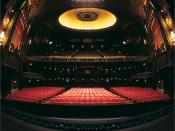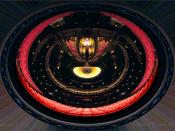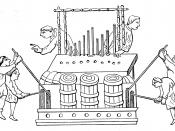We think about the twelfth century as being captured by elegance, mystery and creative design. This was definitely shown by their costumes. The twelfth century was a time of intense religious worship, and when they performed on stage, the costumes were a release from their everyday restraints. The costumes of this century brought out the flair and individuality of the people wearing them. This had a great impact on theatre because even today, actors and actresses come alive when they get changed for performance.
To show the evolution and slow, steady development of costume, it is necessary to go back to structural beginnings: the trunk-hose, the flat wool caps, and numerous other equally interesting details of dress in the twelfth century.
The twelfth century was a magnificent pageantry of exotic and fantastic costumes, and after the disappearance of classical drama came the age of the liturgical or church drama of Western Europe.
(Hartnoll 36)
Not only was more attention paid to dress, but cosmetics were introduced from the Indies. Cosmetics were a way of hiding or disfiguring one's face to be anyone at all. Those in the twelfth century adored the fact that they could break away from their pale faces and dive into vivid colours and fancy make-up.
It is impossible to illustrate more than a small fraction of the designs that may be found during this period, because its complexity adorns practically each item of apparel from hats to shoes. I have aimed to condense and simplify my essay in hopes of describing typical examples of the garments which, in all probability, were the wear of our predecessors from centuries ago.
England at this period was the sole manufacturer of woolen stuffs; therefore wool, frieze, rugge, broadcloth, kersey, and similar materials were worn extensively in most productions. Only...



Fallacy
This essay is complete fabrication. I assume that you are confused about the century you are talking about. Twelfth century costumes were by no means "captured by elegance, mystery and creative design". As a rule women wore a chemise as an undergarment, sack like dresses to the ankle, the variations of the dress were back and side laces. Men wore shirts with a tunic, breaches and hoes. Cloaks were more often then not from ankle length or knee length.
From the sounds of your essay I'm guessing that you would be talking about the 1500-1700 period but it's hard to tell. Your references to twelfth century theater leave me confused.
Have a look at this link.
http://www.costumes.org/pages/medievalinks. htm
3 out of 3 people found this comment useful.